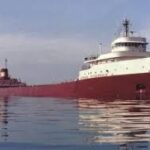 When the SS Edmund Fitzgerald was launched on June 7, 1958, she was the largest ship on North America’s Great Lakes. Today, we mark the 46th anniversary of the sinking of the Edmund Fitzgerald taking her 29 crew members with her to the bottom of Lake Superior during one of the worst of the legendary November storms. She remains the largest ship ever to have sunk there.
When the SS Edmund Fitzgerald was launched on June 7, 1958, she was the largest ship on North America’s Great Lakes. Today, we mark the 46th anniversary of the sinking of the Edmund Fitzgerald taking her 29 crew members with her to the bottom of Lake Superior during one of the worst of the legendary November storms. She remains the largest ship ever to have sunk there.
During last year’s pandemic the memorial service and beacon-lighting were moved to an online-only event. This year the memorial at the Split Rock Lighthouse beacon, located along the Lake Superior shore near Beaver Bay, MN will be, once again an in person event. The lighthouse will be open from 11 a.m. to 6 p.m. on Nov. 10 — a Wednesday this year — with the ceremony set to begin at 4:30 p.m. For those who want to watch online, video will be streamed on the Minnesota Historical Society’s Facebook and YouTube pages.
the annual Nov. 10 ceremony is held on the anniversary of the sinking of the Edmund Fitzgerald, it also remembers those lost in other shipwrecks.
The names of the lost Fitzgerald crew will be read as a bell rings 29 times. After that, lighthouse staff will ring the bell once more — a 30th time — to remember all lost mariners.
Then the Split Rock lighthouse beacon will be lit, shining out over the cold, dark waters of Lake Superior.
Fitzgerald left Superior, Wisconsin on the afternoon of Sunday, November 9, 1975 under the command of Captain Ernest M. McSorley. It was en route to the steel mill on Zug Island, near Detroit, Michigan, with a full cargo of taconite. A second freighter under the command of Captain Jesse B. “Bernie” Cooper, Arthur M. Anderson, destined for Gary, Indiana out of Two Harbors, Minnesota, joined up with Fitzgerald. Fitzgerald, being the faster ship, took the lead while Anderson trailed not far behind. The weather forecast was not unusual for November and called for a storm to pass over eastern Lake Superior and small craft warnings.
Crossing Lake Superior at about 14 knots (26 km/h; 16 mph), the boats encountered a massive winter storm, reporting winds in excess of 50 knots (93 km/h; 58 mph) with gusts up to 86.9 knots (160.9 km/h; 100.0 mph) and waves as high as 35 feet (11 m). Visibility was poor due to heavy snow. The Weather Bureau upgraded the forecast to gale warnings. The freighters altered their courses northward, seeking shelter along the Canadian coast. Later, they would cross to Whitefish Bay to approach the locks.When the storm became intense, the Soo Locks at Sault Ste. Marie were closed.
Late in the afternoon of Monday, November 10, sustained winds of 50 knots were observed across eastern Lake Superior. Anderson was struck by a 75-knot (139 km/h; 86 mph) hurricane-force gust. At 3:30 pm, Captain McSorley radioed the Anderson to report that she was taking on water and had top-side damage including that the Fitzgerald was suffering a list, and had lost two vent covers and some railings. Two of the Fitzgerald’s six bilge pumps were running continuously to discharge shipped water.
At about 3:50 pm, McSorley called the Anderson to report that his radar was not working and he asked the Anderson to keep them in sight while he checked his ship down so that the Anderson could close the gap between them. Fitzgerald was ahead of Anderson at the time, effectively blind; therefore, she slowed to come within 10 miles (16 km) range so she could receive radar guidance from the other ship. For a time the Anderson directed the Fitzgerald toward the relative safety of Whitefish Bay. McSorley contacted the U.S. Coast Guard station in Grand Marais, Michigan after 4:00 pm and then hailed any ships in the Whitefish Point area to inquire if the Whitefish Point light and navigational radio beacon were operational. Captain Cedric Woodard of the Avafors answered that both the light and radio direction beacon were out at that moment. Around 5:30 pm, Woodward called the Fitzgerald again to report that the Whitefish point light was back on but not the radio beacon. When McSorley replied to the Avafors, he commented, “We’re in a big sea. I’ve never seen anything like it in my life.”
The last communication from the doomed ship came at approximately 7:10 pm, when Anderson notified Fitzgerald of an upbound ship and asked how it was doing. McSorley reported, “We are holding our own.” A few minutes later, it apparently sank; no distress signal was received. Ten minutes later Anderson could neither raise Fitzgerald by radio, nor detect it on radar. At 8:32 pm, Anderson was finally able to convince the U. S. Coast Guard that the Fitzgerald had gone missing. Up until that time, the Coast Guard was looking for a 16 foot outboard lost in the area. The United States Coast Guard finally took Captain Cooper of the Anderson seriously shortly after 8:30 pm. The Coast Guard then asked the Anderson to turn around and look for survivors.
The Edmund Fitzgerald now lies under 530 feet of water, broken in two sections. On July 4, 1995, the ship’s bell was recovered from the wreck, and a replica, engraved with the names of the crew members who perished in this tragedy, was left in its place. The original bell is on display at the Great Lakes Shipwreck Museum at Whitefish Point in Michigan.
